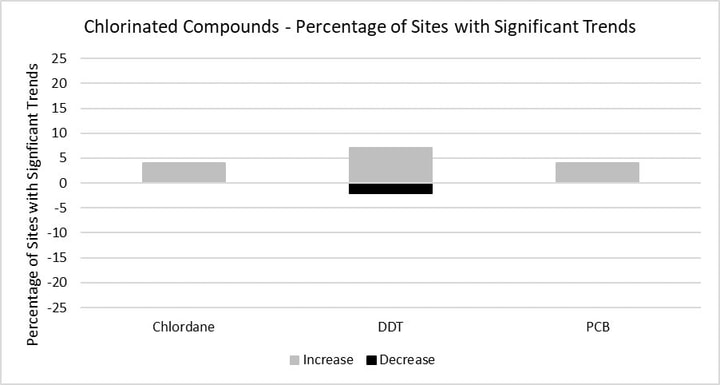DDT (dichlorodiphenyltrichloroethane) is probably the most well-known of the organochlorine (OC) insecticides due to its environmental legacy. DDT was banned for use in the U.S. in 1972, with subsequent bans of other OCs (chlordane, dieldrin, endosulfan, hexachlorocyclohexane, etc.). DDT is considered one of the most insoluble and persistent pesticides ever synthesized (Ware and Whitacre 2004), and it readily bioaccumulates. These chemicals persist in the environment but are not as toxic as many of the current-use pesticides. Trend results for total DDT (the sum of six compounds) and total chlordane (sum of five compounds), are presented as representative of the trends of these chemicals in California streams.
Polychlorinated Biphenyls (PCBs) were used in hundreds of industrial and commercial applications including electrical, heat transfer and hydraulic equipment, plasticizers in paints, plastics and rubber products, and pigments, dyes and carbonless copy paper. They were manufactured domestically until 1979, but because of their stability, they can remain in the environment for long periods, cycling between air, water, and soil. PCBs are generally not acutely toxic, but can bioaccumulate in organisms at the lower end of the food web, and bioconcentrate in higher trophic levels (Beyer and Biziuk 2009). At higher trophic levels, PCBs can cause endocrine and neurological effects (Fonnum and Mariussen 2009). Individual PCB congeners occur in mixtures in the environment, and for the purposes of this program, congeners were summed to determine trends.
Chlordane appears to be increasing statewide and is driven by significant increases at only four sites. No significant trends were detected for Sum DDT, and stable trends were detected for Sum PCBs. Concentrations of chlordane had significant correlations with both urban and agricultural land uses, whereas concentrations of PCBs had a significant correlation with urban land use. Concentrations of Sum DDT and Sum PCB at a few individual sites were also significantly increasing, but decreasing trends were also noted for Sum DDT.
References
Polychlorinated Biphenyls (PCBs) were used in hundreds of industrial and commercial applications including electrical, heat transfer and hydraulic equipment, plasticizers in paints, plastics and rubber products, and pigments, dyes and carbonless copy paper. They were manufactured domestically until 1979, but because of their stability, they can remain in the environment for long periods, cycling between air, water, and soil. PCBs are generally not acutely toxic, but can bioaccumulate in organisms at the lower end of the food web, and bioconcentrate in higher trophic levels (Beyer and Biziuk 2009). At higher trophic levels, PCBs can cause endocrine and neurological effects (Fonnum and Mariussen 2009). Individual PCB congeners occur in mixtures in the environment, and for the purposes of this program, congeners were summed to determine trends.
Chlordane appears to be increasing statewide and is driven by significant increases at only four sites. No significant trends were detected for Sum DDT, and stable trends were detected for Sum PCBs. Concentrations of chlordane had significant correlations with both urban and agricultural land uses, whereas concentrations of PCBs had a significant correlation with urban land use. Concentrations of Sum DDT and Sum PCB at a few individual sites were also significantly increasing, but decreasing trends were also noted for Sum DDT.
References
- Beyer A, Biziuk M. 2009. Environmental Fate and Global Distribution of Polychlorinated Biphenyls. In: Whitacre DM, editor. Reviews of Environmental Contamination and Toxicology, Vol 201. p. 137-158.
- Fonnum F, Mariussen E. 2009. Mechanisms involved in the neurotoxic effects of environmental toxicants such as polychlorinated biphenyls and brominated flame retardants. Journal of Neurochemistry 111(6):1327-1347.
- Ware GW, Whitacre D. 2004. The Pesticide Book, 6th Edition. Fresno, CA: Thompson Publications.

